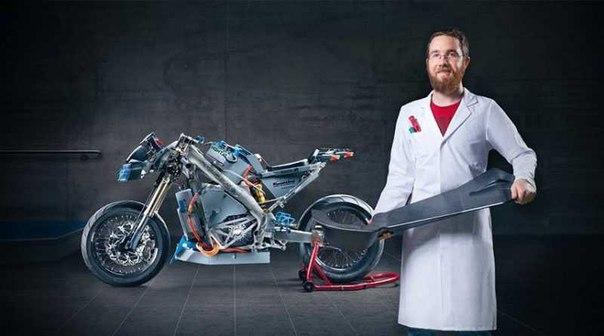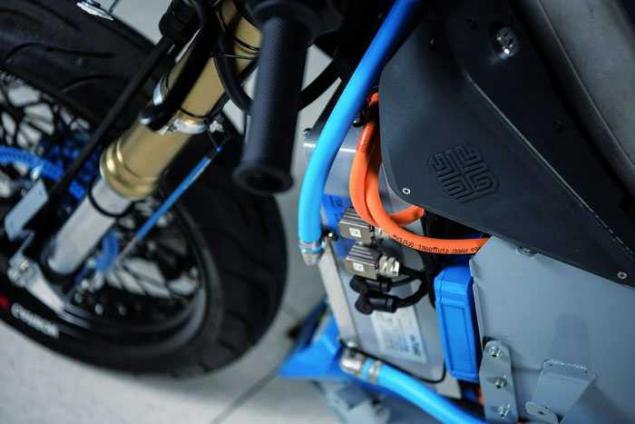546
Unique elektrobayk by students from the University of Darmstadt
Motorcycle has always attracted the young part of the population. Therefore, it is not surprising that the development of the bike with an electric drive engaged students from the University of Darmstadt. Very often young people use this subject in their diploma and course works. Many of these studies go unnoticed, but some are bright and successful event in motokonstruirovaniya. So it was with Gauss Concept project that has developed a student at the University of Marseille Attila Kiss. His work was the subject of the thesis back in 2010.

Racing forms and a variety of innovative solutions immediately attracted the attention of experts and amateurs bikes. An improved cooling system, regenerative capabilities, transmitted through the front wheel was forced to draw the attention of the teachers of the Technical University. Of course, KISS was not difficult to defend his thesis and received a degree in design. Naturally, KISS also wanted to bring the project to its logical conclusion and to create a working model. Through sponsorship, he was able to carry out his plan.

At this point, the Gauss project united around itself about 50 students who are actively involved in the development and research and achieved fairly good results. During the first start elektrobayka in 2014, he demonstrated a speed of 150 km / h. Innovative implementation helped to improve the result of up to 220 km / h.
Rear-wheel drive and the process of recovery
Initially Marseille Attila Kiss tried to use in the project a progressive recovery process. This system allows during braking or driving "vnakat 'to store energy and give it to a power source. For the first time applied to the recovery of the known races of "Formula 1". The kinetic energy during braking is transformed into electricity, and an electric motor at some point performs the function generator.
The idea is not new, but Gauss Concept project has acquired some of the features. They concluded that the regeneration process occurs in the front wheel, rather than in the rear, where the motor is installed. The changes brought a more efficient use of the kinetic energy as the rear wheel off the ground during braking. In elektromototsikl Gaussian calculation is based on the use of the front-wheel power. In this case, the effect - the maximum
. The problems that can be dealt
However, not all is rosy. Because the electric motor is located in the central part elektromototsikl, there is the problem of braking torque transmission. For this it was necessary to apply complicated drive mechanism of the telescopic type. Another mechanism controls the neutral position of the steering wheel at the time of the use of electric brakes. All development efforts have focused on trying to make the electric brake is equivalent in sensitivity to mechanical. Not the least role in this issue played a relatively small weight elektrobayka - 170 kg
. Fight for millimeters
Marseille Attila Kiss demands from his assistants, so they are very carefully treated to save the use of each millimeter bike.

First, the battery cells 550 consisting of fully occupies the space of the frame. The total weight of these cells is equal to 41 kilogram. Such massive construction is justified: 60% leased with recovery of mechanical energy is transformed into electricity. The research team plans - bring this figure up to 80%
. Secondly, the area of the frame is also used for distribution of high-voltage cables therein. Usage voltage - 370V with the electric current - 200A. It is obvious that the data cables are put forward higher requirements. Developers had to seek help from a leading manufacturer of cable products and related items - the company Lapp. The company's specialists have given competent advice and offered the best options. We stopped on the use of project control cables - OLFLEX®. Their main positive quality - flexibility and a small bending radius. Due to the on-screen shell, they are not afraid of interference from electromagnetic fields.
Gauss team has already identified for themselves the future plans - the creation of a racing bike, designed to take part in sports in 2016.

Racing forms and a variety of innovative solutions immediately attracted the attention of experts and amateurs bikes. An improved cooling system, regenerative capabilities, transmitted through the front wheel was forced to draw the attention of the teachers of the Technical University. Of course, KISS was not difficult to defend his thesis and received a degree in design. Naturally, KISS also wanted to bring the project to its logical conclusion and to create a working model. Through sponsorship, he was able to carry out his plan.

At this point, the Gauss project united around itself about 50 students who are actively involved in the development and research and achieved fairly good results. During the first start elektrobayka in 2014, he demonstrated a speed of 150 km / h. Innovative implementation helped to improve the result of up to 220 km / h.
Rear-wheel drive and the process of recovery
Initially Marseille Attila Kiss tried to use in the project a progressive recovery process. This system allows during braking or driving "vnakat 'to store energy and give it to a power source. For the first time applied to the recovery of the known races of "Formula 1". The kinetic energy during braking is transformed into electricity, and an electric motor at some point performs the function generator.
The idea is not new, but Gauss Concept project has acquired some of the features. They concluded that the regeneration process occurs in the front wheel, rather than in the rear, where the motor is installed. The changes brought a more efficient use of the kinetic energy as the rear wheel off the ground during braking. In elektromototsikl Gaussian calculation is based on the use of the front-wheel power. In this case, the effect - the maximum
. The problems that can be dealt
However, not all is rosy. Because the electric motor is located in the central part elektromototsikl, there is the problem of braking torque transmission. For this it was necessary to apply complicated drive mechanism of the telescopic type. Another mechanism controls the neutral position of the steering wheel at the time of the use of electric brakes. All development efforts have focused on trying to make the electric brake is equivalent in sensitivity to mechanical. Not the least role in this issue played a relatively small weight elektrobayka - 170 kg
. Fight for millimeters
Marseille Attila Kiss demands from his assistants, so they are very carefully treated to save the use of each millimeter bike.

First, the battery cells 550 consisting of fully occupies the space of the frame. The total weight of these cells is equal to 41 kilogram. Such massive construction is justified: 60% leased with recovery of mechanical energy is transformed into electricity. The research team plans - bring this figure up to 80%
. Secondly, the area of the frame is also used for distribution of high-voltage cables therein. Usage voltage - 370V with the electric current - 200A. It is obvious that the data cables are put forward higher requirements. Developers had to seek help from a leading manufacturer of cable products and related items - the company Lapp. The company's specialists have given competent advice and offered the best options. We stopped on the use of project control cables - OLFLEX®. Their main positive quality - flexibility and a small bending radius. Due to the on-screen shell, they are not afraid of interference from electromagnetic fields.
Gauss team has already identified for themselves the future plans - the creation of a racing bike, designed to take part in sports in 2016.
Backpack for gadzhetomanov Lifepack conquered Kickstarter
This is a simple tool to clean the intestines as a brush























